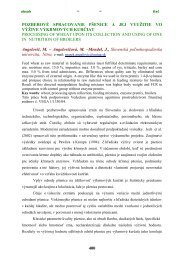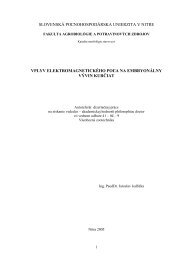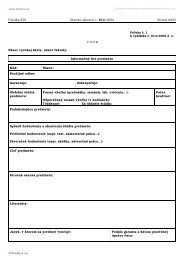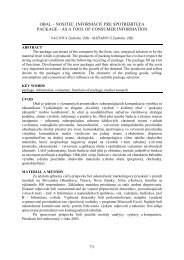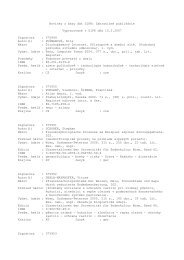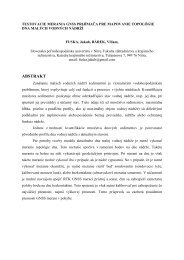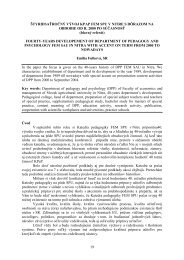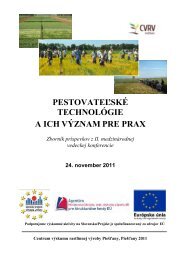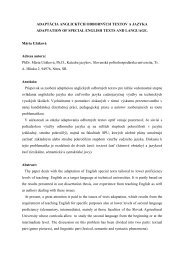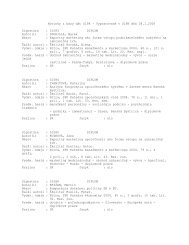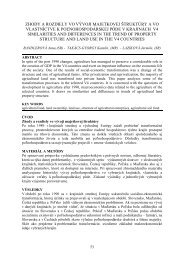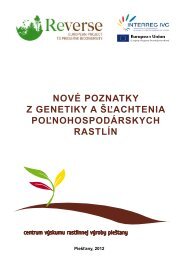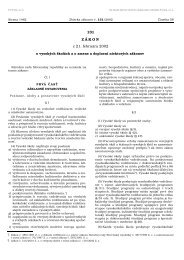Acta fytotechnica et zootechnica, Vol. 4, 2001, Special Number ...
Acta fytotechnica et zootechnica, Vol. 4, 2001, Special Number ...
Acta fytotechnica et zootechnica, Vol. 4, 2001, Special Number ...
You also want an ePaper? Increase the reach of your titles
YUMPU automatically turns print PDFs into web optimized ePapers that Google loves.
<strong>Acta</strong> <strong>fytotechnica</strong> <strong>et</strong> <strong>zootechnica</strong>, <strong>Vol</strong>. 4, <strong>2001</strong>, <strong>Special</strong> <strong>Number</strong><br />
Proceedings of the International Scientific Conference on the Occasion of the 55 th Anniversary of the Slovak Agricultural<br />
University in Nitra<br />
In the case of intensive agricultural exploitation of the territory of the East-Slovakian Lowland the decisive task play<br />
the waterworks regulations not only in the protection against flood, but especially for taking the internal waters in the<br />
required level mode as well as time mode and the systematic drainage and the irrigation at the regulation of the<br />
conditions of humidity in the soil.<br />
In continuity with the rational exploitation of the production potential of the soils the most important claim is the covering of<br />
the very heavy Pseudogleysols and Eutric fluvisols with the grass vesture to coherence with their unfavourable water<br />
mode. The localities of the peripheral regions represent particularly Albic luvisols, Eutric cambisols and Plano-gleyic<br />
luvisols. Typical is the late start of the spring field works and significant shortage of the soil water supply in the<br />
summer period. Therefore, they require the specific structure of the plant production with the orientation to winter<br />
cereals and winter rape.<br />
Concerning the complex natural but especially economic conditions it is not possible the universal recipe as far as the<br />
optimalization of the relation b<strong>et</strong>ween water and air is concerned as well as the whole system of farming on the East-<br />
Slovakian Lowland. However, the worked-out programme of the agricultural development on the East-Slovakian Lowland<br />
up to 2005 indicate the possible aim and the efficiency.<br />
References<br />
BEDRNA, J.: Pôdoochranné procesy a pôdne režimy. VEDA, Bratislava, 1977, 129 s.<br />
FULAJTÁR, E.: Fyzikálne vlastnosti pôd Slovenska, ich úprava a využitie. VEDA, Bratislava, 1986.<br />
ŠÚTOR, J. a kol.: Hydrológia Východoslovenskej nížiny. MediaGroup, Michalovce, 1995, 467 s.<br />
VILČEK, J.: Interpr<strong>et</strong>ácia bonitácie pôd na Východoslovenskej nížine. In: Trvalo udržateľný rozvoj poľnohospodárskej výroby<br />
na regionálnej úrovni, I. diel. OVÚA Michalovce, 1998, s. 207-212.<br />
ECONOMICAL ASPECTS OF ALFALFA CROPPING (MEDICAGO SATIVA L.) UNDER DIFFERENT TILLAGE AND<br />
NUTRITION INTENSITY<br />
Introduction<br />
Štefan TÓTH,Pavol PORVAZ, Martin PEŠTA<br />
Research Institute of Agroecology, Špitálska 1273, 071 01 Michalovce, Slovak Republic<br />
Raising production of the veg<strong>et</strong>al mode is in simultaneity fastens in essentially composite economy stipulation, as it was 80-<br />
s. In practise it means to make more with scarceness of working powers, on low acreage soil and with a little cubage<br />
intensificated resources. From this point of view the growing of whichever crops, mainly economically eminent, isn't actual<br />
without respecting intensificated factors, with provide suitable harvest and its qualitative indicators.<br />
A matter of fact sits about the economic stature perennial fodder crops, that form the orientation acreage cca 1.500.555 ha<br />
arable soil in Slovakia steady engaged 10-14 % (table 1), along there is a visible acreage decline in after-transformation<br />
period against before-transformation. By its 45 -59 % alfalfa stands as a dominating crop within the frame of perennial<br />
fodder crops, by relatively deuces productions. Despite of its biological strangeness, thus meaning monumental and<br />
profound radical system with nitrogen – assimilating bacteria comp<strong>et</strong>ent to swab and release some nutrients also from and<br />
from the lesser accessible forms and more profound layers as well as to bind the airy nitrogen, is nourishment, e.j. a yearly<br />
phosphorus and potassium requirement as well as startup nitrous amount, the most intensificated factor for alfalfa growing.<br />
In latter conception besides there is also tillage system of soil, which confirms a manifest interest in about economy or<br />
minimum alternatives also in a case "garden s<strong>et</strong>-out exigent" alfalfa.<br />
Material and m<strong>et</strong>hods<br />
In this work, we to decline the exact scientific results gained by the variant growing of alfalfa, considering more extensive<br />
and intense style growing, in sense of nutrition as well as processing system soil, heading to the fall in value or to the<br />
increase in value of the true profitability and profit, or to the loss formation. This work also shows the real production figures<br />
of the alfalfa, the vari<strong>et</strong>y PALAVA of seeding 5 mil. germine grains.ha -1 , as well as the levels of own costs under three<br />
tillage system:<br />
1, Conventional – ploughing 24 cm + classic seedbad preparation<br />
2, Reduced - without ploughing + in spring by tiller rotor depth 10 cm<br />
3, No-tillage - seeding to untilled and uncultivated soil seedbad preparation nourishment level (allowances pure nutrients<br />
NPK in kg –1 )<br />
1, intensive (V1) - N - 30, P - 36, to - 115<br />
2, effective V2) - N - 30, P - 32, to - 102<br />
3, nonfertilized control (V3) - with out nutrition<br />
49



